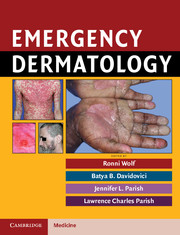Book contents
- Frontmatter
- Contents
- CONTRIBUTORS
- PREFACE
- Chap. 1 CELL INJURY AND CELL DEATH
- Chap. 2 CLEAN AND ASEPTIC TECHNIQUE AT THE BEDSIDE
- Chap. 3 NEW ANTIMICROBIALS
- Chap. 4 IMMUNOMODULATORS AND THE “BIOLOGICS” IN CUTANEOUS EMERGENCIES
- Chap. 5 CRITICAL CARE: STUFF YOU REALLY, REALLY NEED TO KNOW
- Chap. 6 ACUTE SKIN FAILURE: CONCEPT, CAUSES, CONSEQUENCES, AND CARE
- Chap. 7 CUTANEOUS SYMPTOMS AND NEONATAL EMERGENCIES
- Chap. 8 NECROTIZING SOFT-TISSUE INFECTIONS, INCLUDING NECROTIZING FASCIITIS
- Chap. 9 LIFE-THREATENING BACTERIAL SKIN INFECTIONS
- Chap. 10 BACTEREMIA, SEPSIS, SEPTIC SHOCK, AND TOXIC SHOCK SYNDROME
- Chap. 11 STAPHYLOCOCCAL SCALDED SKIN SYNDROME
- Chap. 12 LIFE-THREATENING CUTANEOUS VIRAL DISEASES
- Chap. 13 LIFE-THREATENING CUTANEOUS FUNGAL AND PARASITIC DISEASES
- Chap. 14 LIFE-THREATENING STINGS, BITES, AND MARINE ENVENOMATIONS
- Chap. 15 SEVERE, ACUTE ADVERSE CUTANEOUS DRUG REACTIONS I: STEVENS–JOHNSON SYNDROME AND TOXIC EPIDERMAL NECROLYSIS
- Chap. 16 SEVERE, ACUTE ADVERSE CUTANEOUS DRUG REACTIONS II: DRESS SYNDROME AND SERUM SICKNESS-LIKE REACTION
- Chap. 17 SEVERE, ACUTE COMPLICATIONS OF DERMATOLOGIC THERAPIES
- Chap. 18 SEVERE, ACUTE ALLERGIC AND IMMUNOLOGICAL REACTIONS I: URTICARIA, ANGIOEDEMA, MASTOCYTOSIS, AND ANAPHYLAXIS
- Chap. 19 SEVERE, ACUTE ALLERGIC AND IMMUNOLOGICAL REACTIONS II: OTHER HYPERSENSITIVITIES AND IMMUNE DEFECTS, INCLUDING HIV
- Chap. 20 GRAFT VERSUS HOST DISEASE
- Chap. 21 ERYTHRODERMA/EXFOLIATIVE DERMATITIS
- Chap. 22 ACUTE, SEVERE BULLOUS DERMATOSES
- Chap. 23 EMERGENCY MANAGEMENT OF PURPURA AND VASCULITIS, INCLUDING PURPURA FULMINANS
- Chap. 24 EMERGENCY MANAGEMENT OF CONNECTIVE TISSUE DISORDERS AND THEIR COMPLICATIONS
- Chap. 25 SKIN SIGNS OF SYSTEMIC INFECTIONS
- Chap. 26 SKIN SIGNS OF SYSTEMIC NEOPLASTIC DISEASES AND PARANEOPLASTIC CUTANEOUS SYNDROMES
- Chap. 27 BURN INJURY
- Chap. 28 EMERGENCY DERMATOSES OF THE ANORECTAL REGIONS
- Chap. 29 EMERGENCY MANAGEMENT OF SEXUALLY TRANSMITTED DISEASES AND OTHER GENITOURETHRAL DISORDERS
- Chap. 30 EMERGENCY MANAGEMENT OF ENVIRONMENTAL SKIN DISORDERS: HEAT, COLD, ULTRAVIOLET LIGHT INJURIES
- Chap. 31 ENDOCRINOLOGIC EMERGENCIES IN DERMATOLOGY
- Chap. 32 EMERGENCY MANAGEMENT OF SKIN TORTURE AND SELF-INFLICTED DERMATOSES
- Chap. 33 SKIN SIGNS OF POISONING
- Chap. 34 DISASTER PLANNING: MASS CASUALTY MANAGEMENT
- Chap. 35 CATASTROPHES IN COSMETIC PROCEDURES
- Chap. 36 LIFE-THREATENING DERMATOSES IN TRAVELERS
- Index
- References
Chap. 4 - IMMUNOMODULATORS AND THE “BIOLOGICS” IN CUTANEOUS EMERGENCIES
Published online by Cambridge University Press: 07 September 2011
- Frontmatter
- Contents
- CONTRIBUTORS
- PREFACE
- Chap. 1 CELL INJURY AND CELL DEATH
- Chap. 2 CLEAN AND ASEPTIC TECHNIQUE AT THE BEDSIDE
- Chap. 3 NEW ANTIMICROBIALS
- Chap. 4 IMMUNOMODULATORS AND THE “BIOLOGICS” IN CUTANEOUS EMERGENCIES
- Chap. 5 CRITICAL CARE: STUFF YOU REALLY, REALLY NEED TO KNOW
- Chap. 6 ACUTE SKIN FAILURE: CONCEPT, CAUSES, CONSEQUENCES, AND CARE
- Chap. 7 CUTANEOUS SYMPTOMS AND NEONATAL EMERGENCIES
- Chap. 8 NECROTIZING SOFT-TISSUE INFECTIONS, INCLUDING NECROTIZING FASCIITIS
- Chap. 9 LIFE-THREATENING BACTERIAL SKIN INFECTIONS
- Chap. 10 BACTEREMIA, SEPSIS, SEPTIC SHOCK, AND TOXIC SHOCK SYNDROME
- Chap. 11 STAPHYLOCOCCAL SCALDED SKIN SYNDROME
- Chap. 12 LIFE-THREATENING CUTANEOUS VIRAL DISEASES
- Chap. 13 LIFE-THREATENING CUTANEOUS FUNGAL AND PARASITIC DISEASES
- Chap. 14 LIFE-THREATENING STINGS, BITES, AND MARINE ENVENOMATIONS
- Chap. 15 SEVERE, ACUTE ADVERSE CUTANEOUS DRUG REACTIONS I: STEVENS–JOHNSON SYNDROME AND TOXIC EPIDERMAL NECROLYSIS
- Chap. 16 SEVERE, ACUTE ADVERSE CUTANEOUS DRUG REACTIONS II: DRESS SYNDROME AND SERUM SICKNESS-LIKE REACTION
- Chap. 17 SEVERE, ACUTE COMPLICATIONS OF DERMATOLOGIC THERAPIES
- Chap. 18 SEVERE, ACUTE ALLERGIC AND IMMUNOLOGICAL REACTIONS I: URTICARIA, ANGIOEDEMA, MASTOCYTOSIS, AND ANAPHYLAXIS
- Chap. 19 SEVERE, ACUTE ALLERGIC AND IMMUNOLOGICAL REACTIONS II: OTHER HYPERSENSITIVITIES AND IMMUNE DEFECTS, INCLUDING HIV
- Chap. 20 GRAFT VERSUS HOST DISEASE
- Chap. 21 ERYTHRODERMA/EXFOLIATIVE DERMATITIS
- Chap. 22 ACUTE, SEVERE BULLOUS DERMATOSES
- Chap. 23 EMERGENCY MANAGEMENT OF PURPURA AND VASCULITIS, INCLUDING PURPURA FULMINANS
- Chap. 24 EMERGENCY MANAGEMENT OF CONNECTIVE TISSUE DISORDERS AND THEIR COMPLICATIONS
- Chap. 25 SKIN SIGNS OF SYSTEMIC INFECTIONS
- Chap. 26 SKIN SIGNS OF SYSTEMIC NEOPLASTIC DISEASES AND PARANEOPLASTIC CUTANEOUS SYNDROMES
- Chap. 27 BURN INJURY
- Chap. 28 EMERGENCY DERMATOSES OF THE ANORECTAL REGIONS
- Chap. 29 EMERGENCY MANAGEMENT OF SEXUALLY TRANSMITTED DISEASES AND OTHER GENITOURETHRAL DISORDERS
- Chap. 30 EMERGENCY MANAGEMENT OF ENVIRONMENTAL SKIN DISORDERS: HEAT, COLD, ULTRAVIOLET LIGHT INJURIES
- Chap. 31 ENDOCRINOLOGIC EMERGENCIES IN DERMATOLOGY
- Chap. 32 EMERGENCY MANAGEMENT OF SKIN TORTURE AND SELF-INFLICTED DERMATOSES
- Chap. 33 SKIN SIGNS OF POISONING
- Chap. 34 DISASTER PLANNING: MASS CASUALTY MANAGEMENT
- Chap. 35 CATASTROPHES IN COSMETIC PROCEDURES
- Chap. 36 LIFE-THREATENING DERMATOSES IN TRAVELERS
- Index
- References
Summary
BIOLOGIC AGENTS are proteins or antibodies engineered to target specific molecules. They are derived from the products of living organisms. In recent years, numerous drugs of this type have been added to the therapeutic armamentarium in various disciplines of medicine. In dermatology, psoriasis is so far the only entity for which various drugs of this type are approved. Two main groups of biologic agents are used in psoriasis: The first is tumor necrosis factor (TNF) blockers, and the second group consists of inhibitors of T lymphocytes or antigen-presenting cells. Drugs from the anti-TNF group, as well as additional biological agents from other specialties, have been used off-label in numerous skin diseases – some of them are dermatologic emergencies. No doubt, the increasing development and use of these drugs will also extend the number of possible indications in numerous skin diseases. This chapter reviews the current reports on these agents and their use in various dermatologic emergencies (Table 4.1).
INFLIXIMAB
Infliximab (Remicade; Centocor, Inc., Horsham, PA) is a chimeric immunoglobulin G1 (IgG1) monoclonal antibody containing human constant regions and murine variable regions. It binds and inhibits both soluble and transmembrane TNF-α and activates lysis of cells that express transmembrane TNF-α via antibody-dependent and complement-dependent cytotoxic mechanisms.
Indications
Indications for treating are rheumatoid arthritis (RA), psoriatic arthritis, ankylosing spondylitis, Crohn disease, ulcerative colitis, and moderate to severe plaque type psoriasis.
- Type
- Chapter
- Information
- Emergency Dermatology , pp. 34 - 49Publisher: Cambridge University PressPrint publication year: 2011

